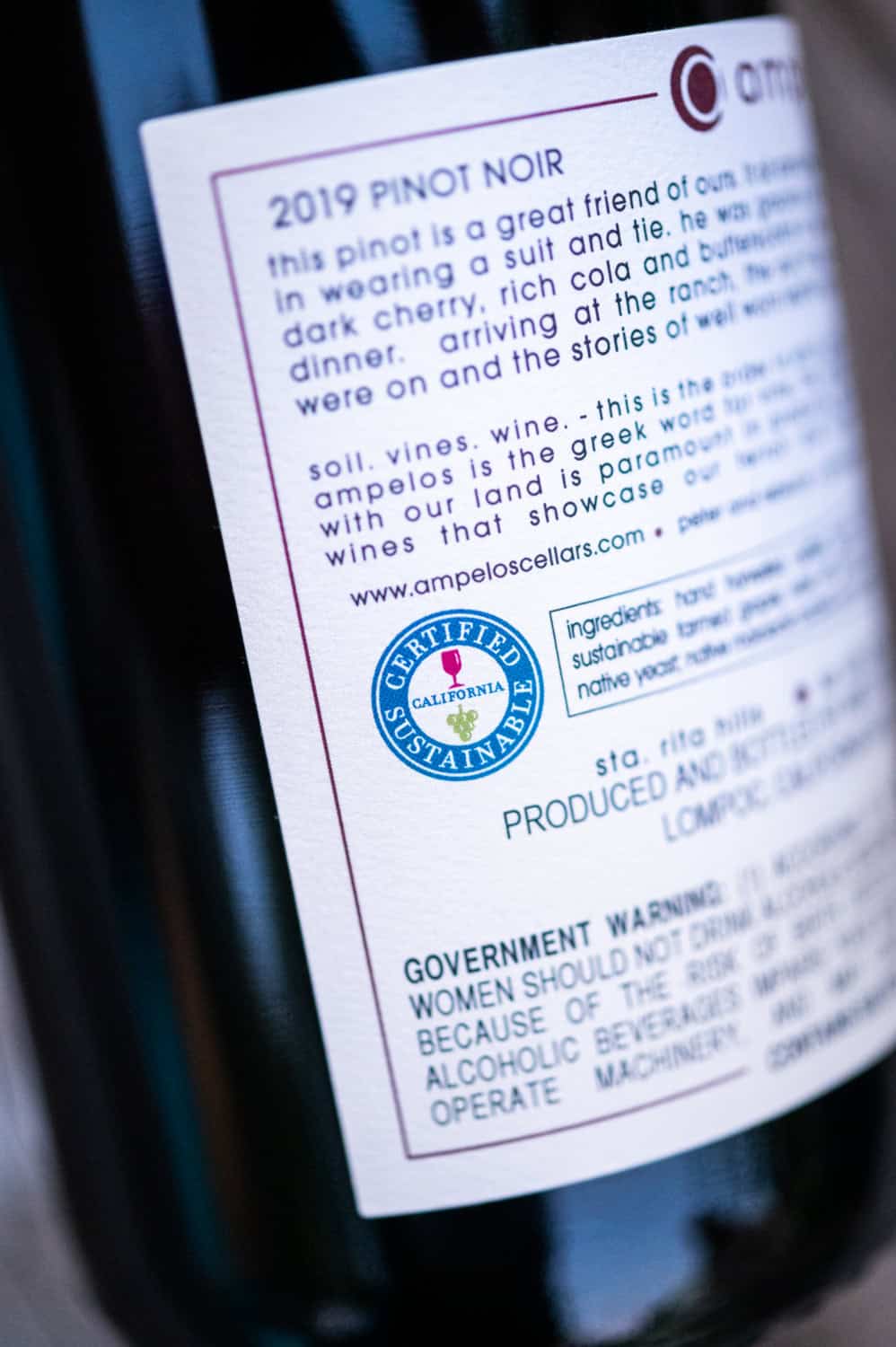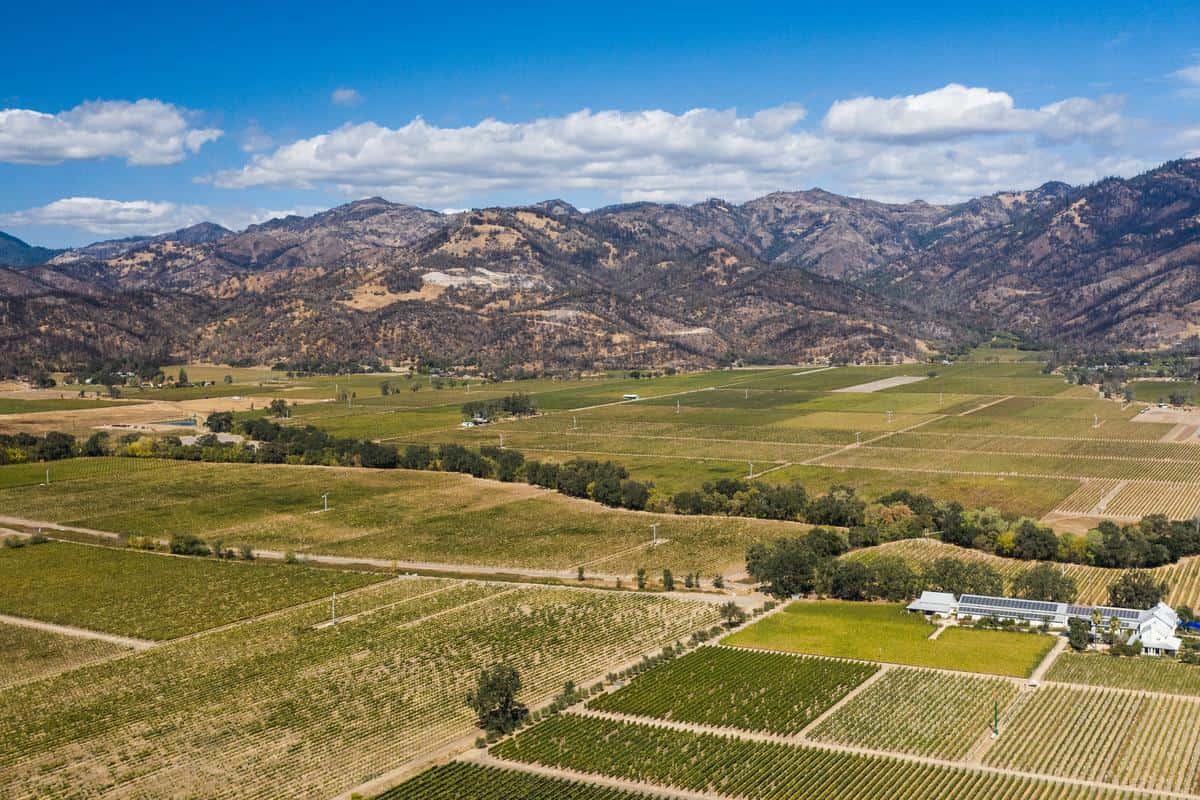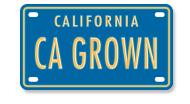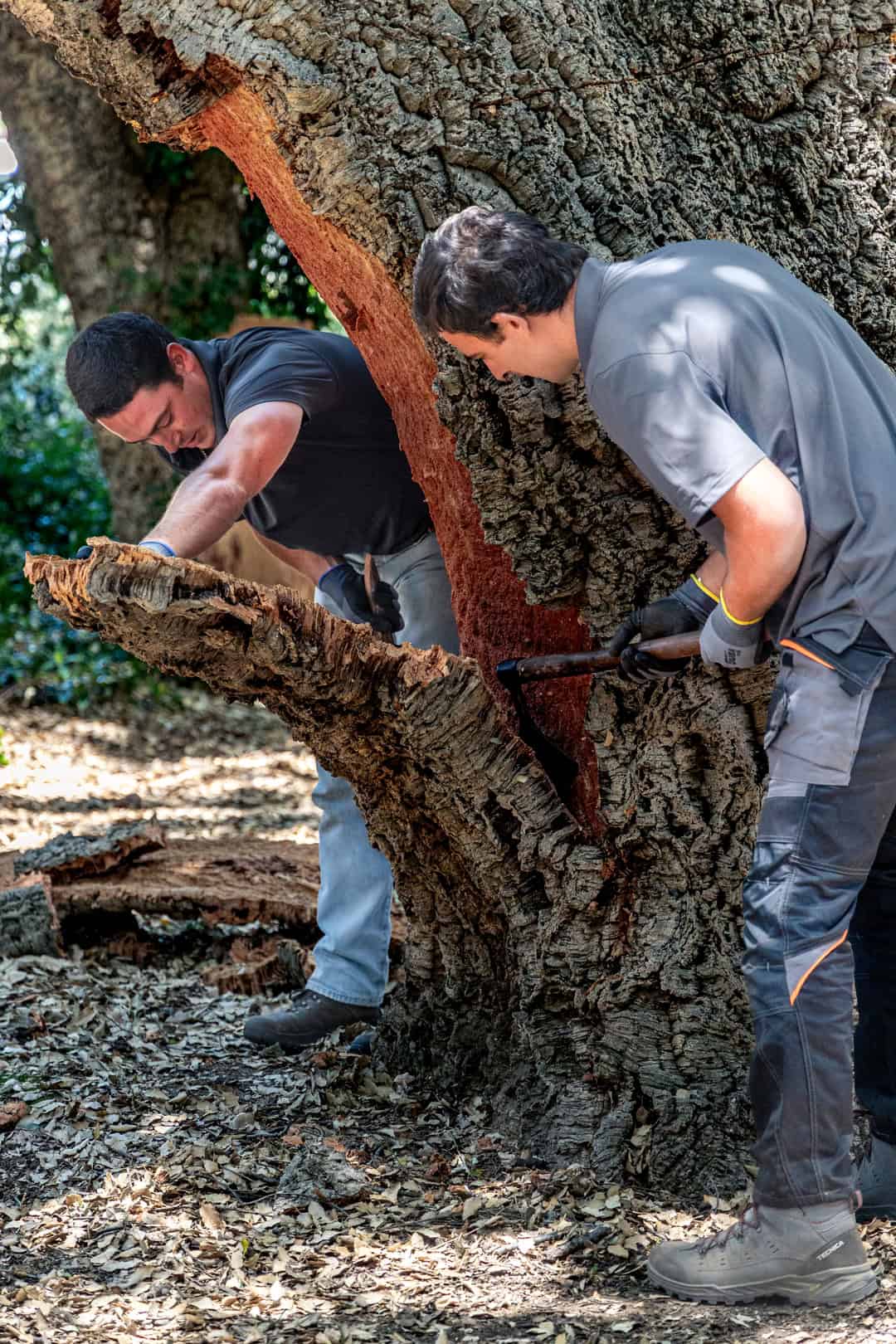What is cork and how is it harvested?
Cork is famously used as a wine closure, but have you ever wondered why? We met with a few folks from Cork Supply and the University of California, Davis (UC Davis) to uncover what cork really is, how it’s harvested, why it’s an incredibly sustainable choice for wine closures and more!
What is cork?
Simply put, cork is the bark of a cork oak tree. From a sustainability perspective, it is desirable since it is a natural carbon-negative product useful for a variety of purposes, including flooring and fashion. Its most common use, however, is as a bottle closure for alcoholic beverages.
Where does cork grow?
Cork oak trees are native to the Iberian Peninsula. Just in case your geography is a little rusty, that’s Spain, Portugal, Andorra, Gibraltar and part of France. Today, the trees are found throughout the Mediterranean Basin, but most commercial production takes place in Portugal and Spain.
Because California’s temperate climate is similar to that of the Mediterranean, cork oaks can grow in parts of the Golden State. The majority of cork oaks in California are scattered along the coast, but some can be found further inland. For example, UC Davis is home to 532 cork trees! You might even find a cork oak for sale at your local retail nursery.
How is cork harvested?
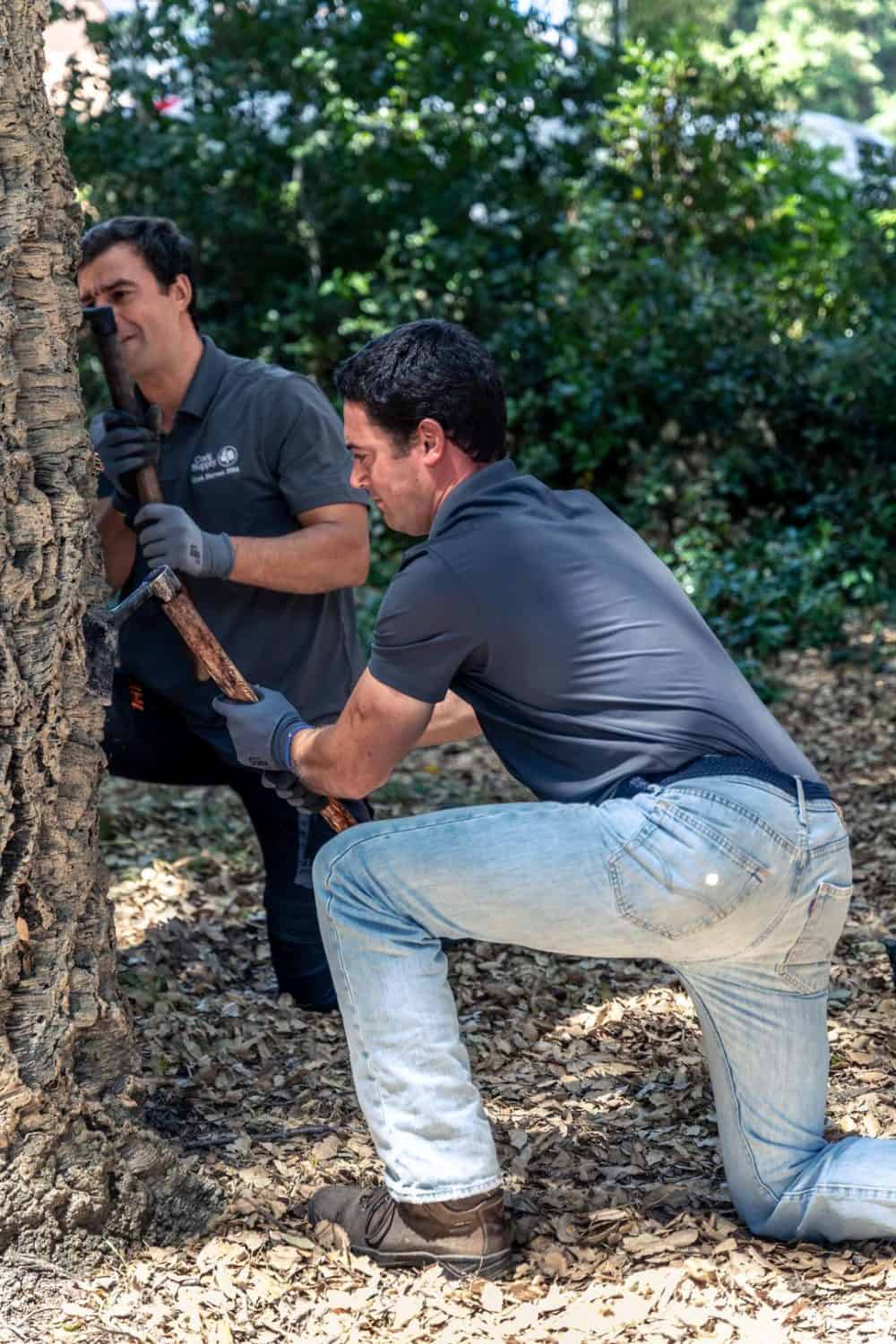
Cork harvesting is a traditional art and one of the highest-paying agricultural jobs in Europe. The skill is often passed down from generation to generation. Highly skilled harvesters work in teams of two, making careful incisions to remove the outer layer of bark without damaging the tree.
This work is done all by hand – with axes. If you’ve never witnessed a cork harvest, you’re probably imagining something a little more…violent. In reality, it’s artful – more like a well-timed dance. The teams frequently work together, building both trust and a rhythm that helps them to work safely and effectively. In fact, it typically takes a mere 15-20 minutes for a team to harvest all of the bark from the tree.
Fun Fact: One mature tree can produce up to 1500 wine corks with each harvest!
Does cork harvest damage the tree?
Cork harvest does not damage the tree. Greg Hirson of Cork Supply explains, “Cork is really one of the only trees where you can take all the bark off the tree and it doesn’t harm the tree, as long as you don’t puncture the next layer down.”
How often can cork be harvested?
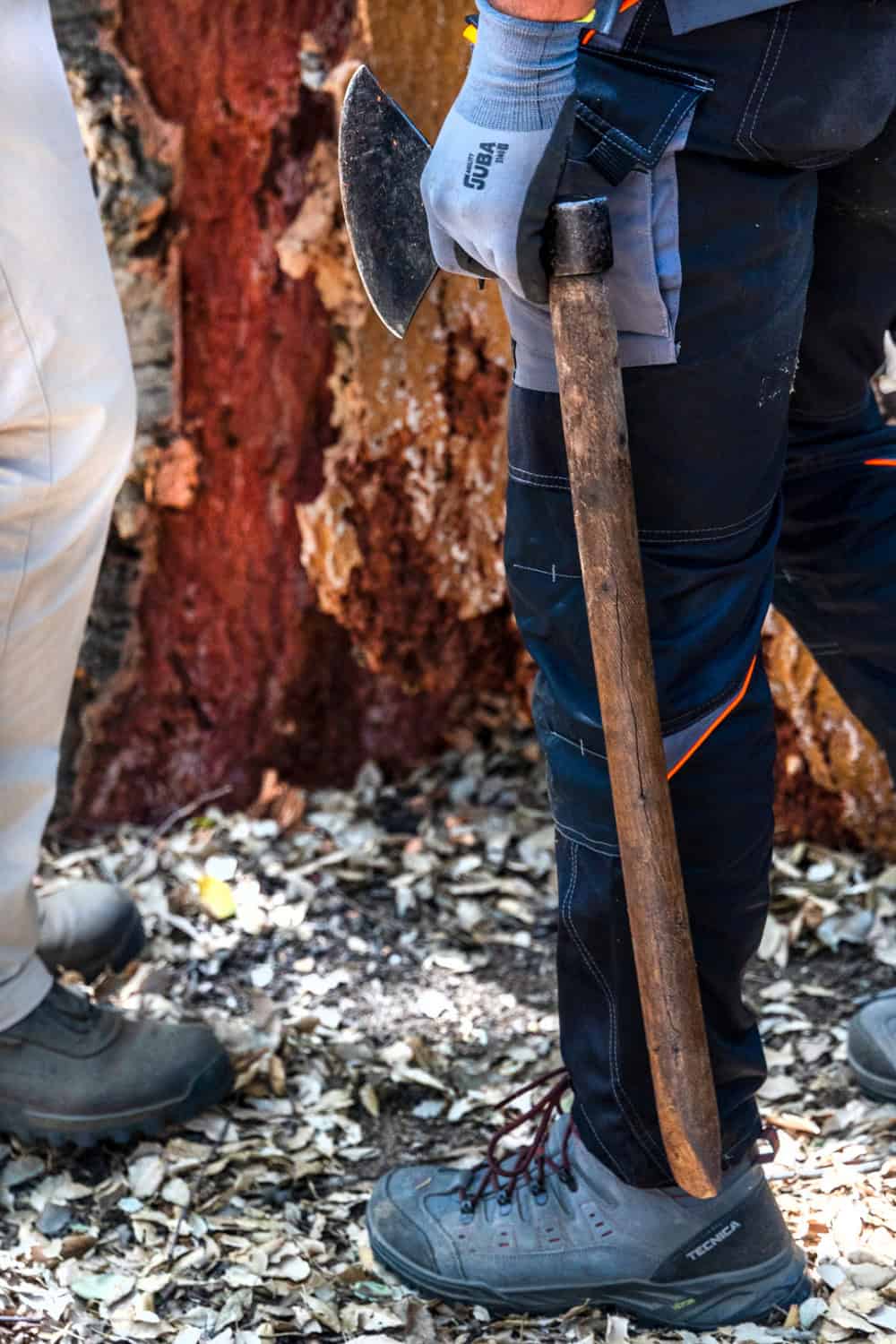
Cork trees are allowed to grow undisturbed for their first 25-27 years. The bark can safely be harvested at that point without killing the tree. This process of harvesting, or stripping the bark from the tree, is called debarking. The bark from the first two harvests is too porous to be used for wine closures, but each time the tree is stripped, the quality of the subsequent bark improves. Federico from Cork Supply elaborates, “With each harvest, you increase quality – the density is getting higher, the cell structure is better, the porosity gets down.”
After the first harvest, the tree is debarked every nine years. It is not until the third harvest that the cork is considered mature and suitable for wine corks.
Did you know…Cork trees live for around 150-200 years, and can be harvested up to 16 times!
What happens after the cork is harvested?
Once the cork is harvested, it’s taken to an aging yard where it ages for six months to a year. After it is sufficiently aged, the cork goes through a boiling process. This helps to flatten out the bark and rehydrate the cells. Then, the cork is cut into strips and punched into closures.
This process takes place both mechanically and by hand. Greg explains, “We feed the bark strips into a machine that punches out as many as possible as close together. We also have some highly skilled cork punchers. They will look at each piece of the bark and choose where they want to punch the bark to get the best cork possible from each strip. Sometimes, if the bark is a little bit curved or it has some cracks and fissures, the automatic punching will just go straight through those cracks and will waste a cork where the humans can look around and see where the best places to punch are and find the best corks in the bark.”
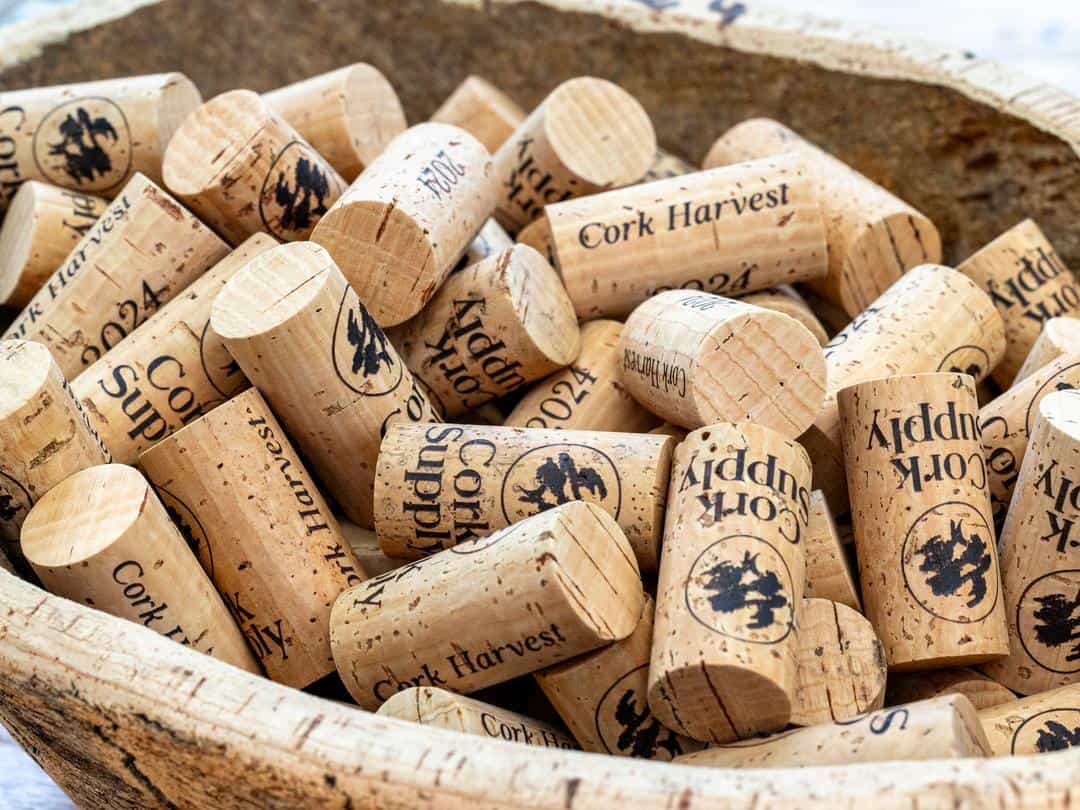
From here, the corks are shaped to exact dimensions, then graded and sorted. Once artwork is added, the corks are finally ready to be shipped out to customers.
Is cork sustainable?
Cork is an environmentally sustainable product. Cork forests are natural carbon sinks. This simply means that they absorb more carbon from the atmosphere than they release. Cork Forests are a nature-based climate solution because they can draw down carbon while providing habitat for native species.
Greg adds, “In the places where corks grow endemically, it’s a very sustainable process. There’s not a lot of input. You don’t have to manage the trees too much. They’re growing naturally – acorns drop and new trees grow. They don’t require watering (other than natural rainfall). The cork oaks are just sitting in the forest, absorbing CO2. Then, when you harvest the cork, you do some minimal processing – but really not much. So really, it’s a very sustainable product and it grows back every nine years.”
Why is cork used to close wine bottles?
Cork has been used as a wine closure for centuries, dating back to the ancient Greeks and Romans. Even today, this traditional closure still reigns supreme, with approximately 70% of all wine bottles having natural corks as a seal.
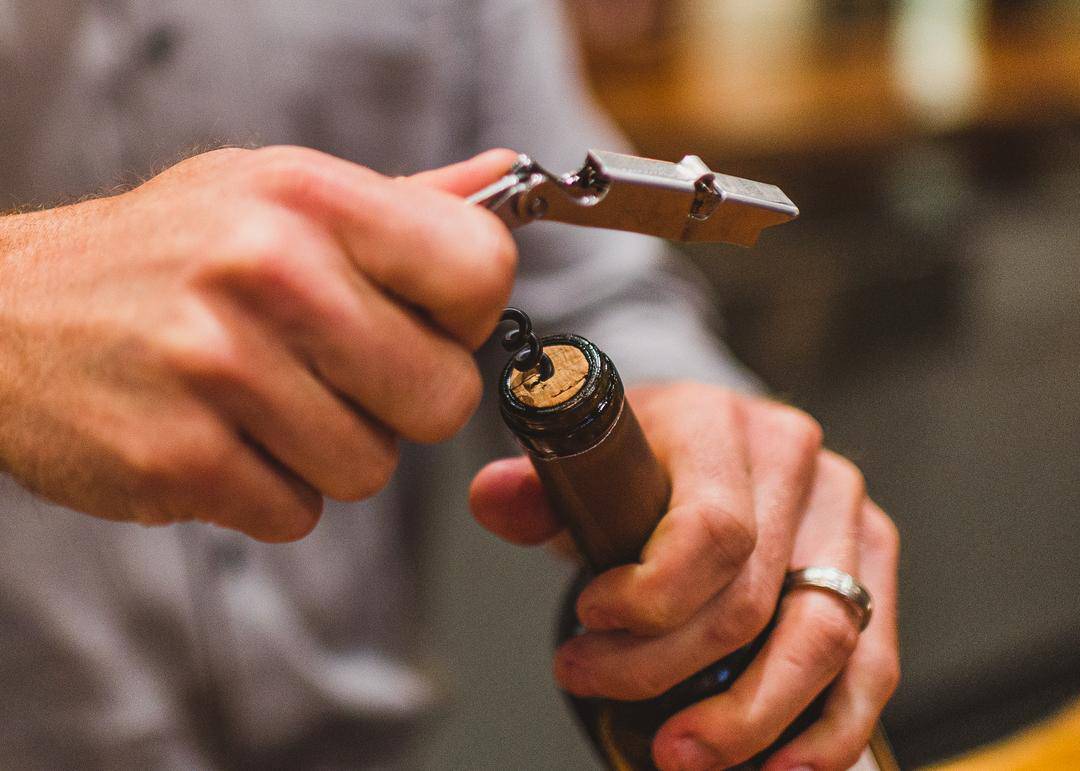
Greg smiles, “It does a really good job of keeping wines in bottles and air out of the bottles. Cork cells have this wax on their cells called suberin. It makes them waterproof and it really doesn’t let gasses in. Even if you were to try to manufacture a product to use as a closure for wine, you’re still only approaching the properties of the corks themselves, which you get straight off a tree.”
Sustainability is incredibly important within the California wine industry. Since packaging accounts for forty to sixty percent of a wine’s carbon footprint, choosing cork closures can help reduce the overall carbon footprint of a bottle of wine. Because cork forests are naturally carbon-negative, cork wine closures are also carbon-negative. Wineries aiming to decrease their carbon footprint or to reach carbon neutrality can look to cork closures to help them achieve those goals.
Does cork affect the flavor of the wine?
Take it from an expert: the cork should not affect the taste of the wine. Dr. Ron C. Runnebaum, Associate Professor of Viticulture and Enology at UC Davis, states, “Several decades ago there were certain chemical compounds that would’ve been found in cork as a result of the processing or growing of the cork. Some of those chemical compounds would’ve made wines smell a little bit musty, or diminished some of the fruity and floral flavors we would have expected in a wine. The industry has done a wonderful job addressing that in the last 30 years. I don’t think that’s much of a concern for winemakers at this point because of the testing and quality control efforts that they (the cork industry) have implemented in their production process and the selection of their raw materials.”
Another past concern with cork usage was inconsistent oxidation. Again, Professor Ron argues that recent technical advances have greatly minimized any concerns.
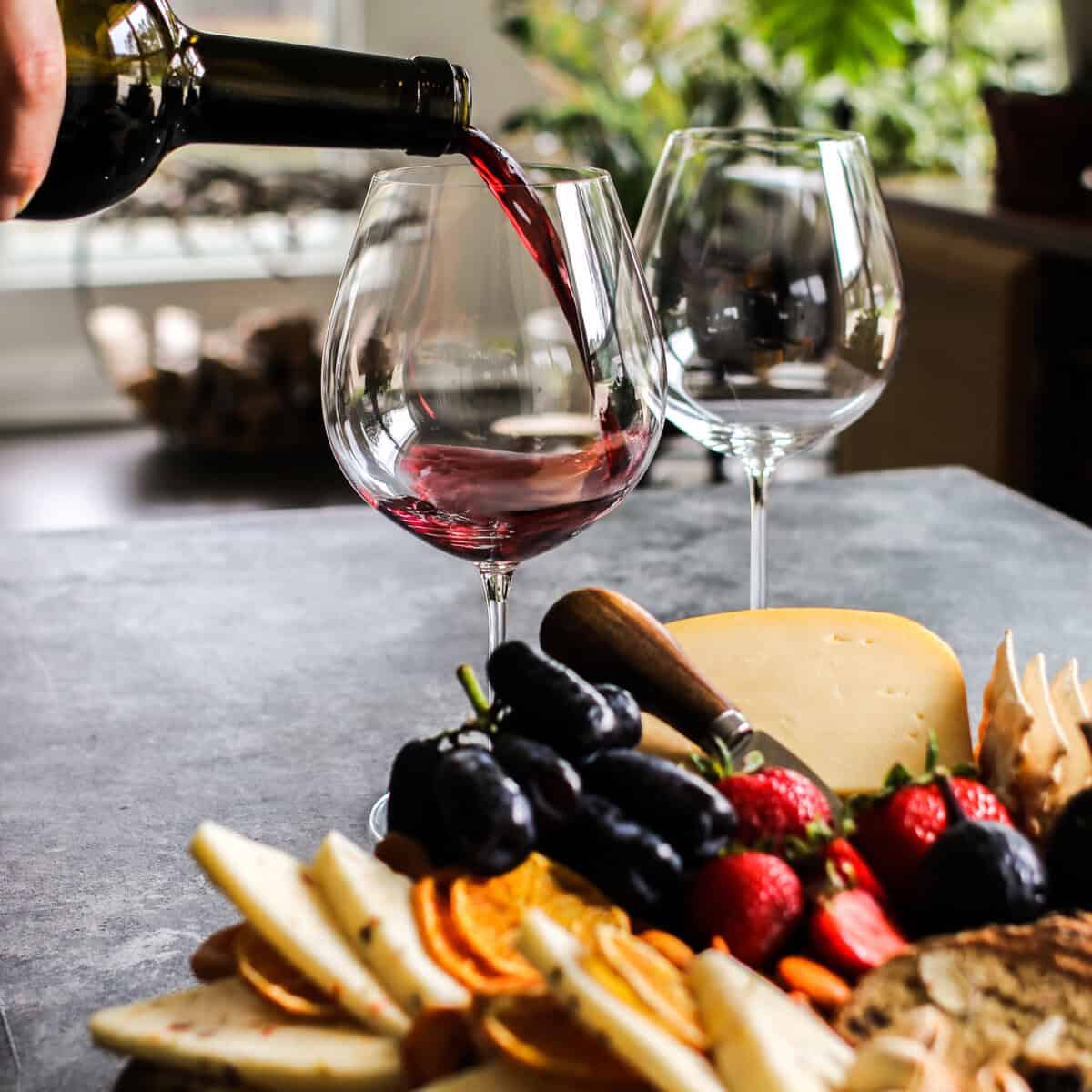
“Once the wine is put into a bottle, oxidation reactions can occur. Consumers would find, if they had a case of wine, one bottle might have been perfect, but when they open the next bottle, they realize they should have consumed that one a couple of years ago. I think that was very frustrating for consumers as well as producers. By developing procedures for analyzing the natural cork and other procedures for making technical corks, they’ve been making great advances in narrowing that variability.”
A Historic UC Davis Harvest
The CA GROWN team was thrilled to learn about the history of the cork groves and to participate in a historic cork harvest on the UC Davis campus. The campus is home to an amazing grove of 80-year-old cork oaks. Cork Supply and UC Davis hosted the event to showcase traditional techniques and to highlight why cork is arguably the most sustainable wine closure.
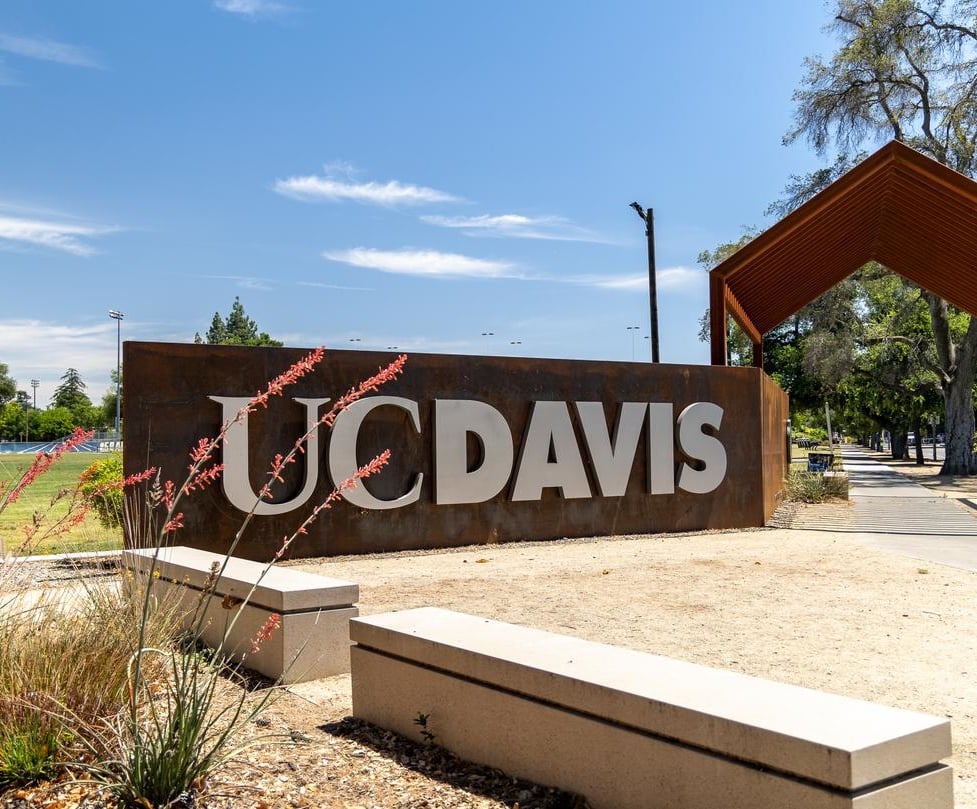
The History of the UC Davis Cork Groves
Emily Griswold, the director of GATEways Horticulture and Teaching Gardens for the UC Davis Arboretum and Public Garden, shares the fascinating history behind the campus’ cork grove.
“These cork oak trees were planted in 1941 as part of a national defense effort during World War II. In addition to being wine stoppers, cork also has industrial uses, everything from life vests to gasket seals to insulation. In the 1940s, it was considered a strategic material. There was concern about not having enough cork because the entire cork supply came from Europe. They were planted by a botany professor and it was part of basically a grassroots effort to develop a domestic source of cork. California has a very similar climate to the Mediterranean region, so cork oak trees can grow quite well here.”
Thankfully, the war ended long before the trees matured. Yet, over the last 80 years, the cork trees thrived, adding to the woodsy ambiance of the Davis Campus. They’ve also provided some incredibly important environmental benefits. Emily adds, “Like any trees, cork oak trees benefit the environment by providing shade. They provide habitat for wildlife. Huge benefits come from trees – they are absorbing rainfall, preventing water runoff, and sequestering carbon. They also benefit our own health and wellbeing. Being around trees actually makes people happier and healthier. There’s actually more research about that every year.”
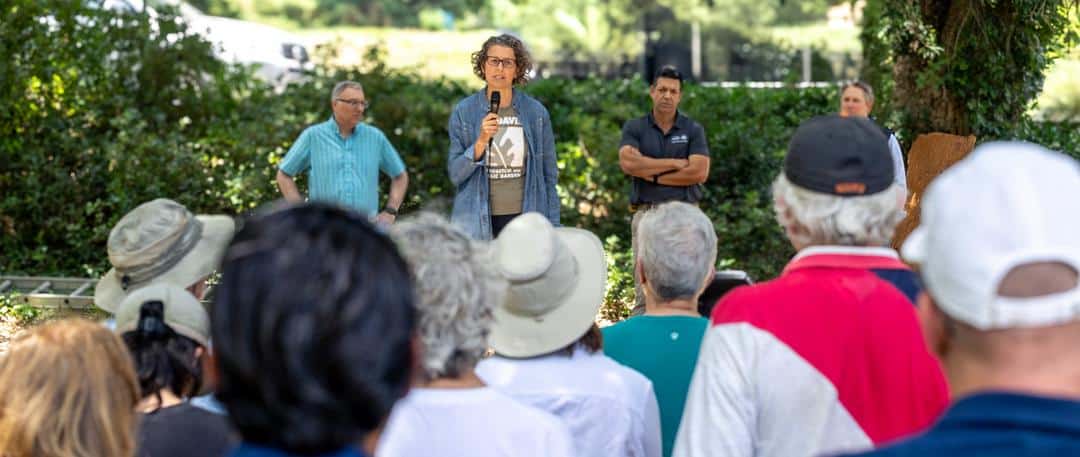
The Harvest Demonstration
Over 100 attendees – including students and wine industry professionals – witnessed the first-ever cork harvest on the UC Davis campus, watching in awe as a highly-skilled two-person team from Portugal expertly removed the outer layer of bark from the tree.
The two men made swift, precise cuts with hand axes until they could remove a large sheet of cork from the tree. Narrating the harvest play-by-play was Greg from Cork Supply, ready to answer any questions from the crowd.
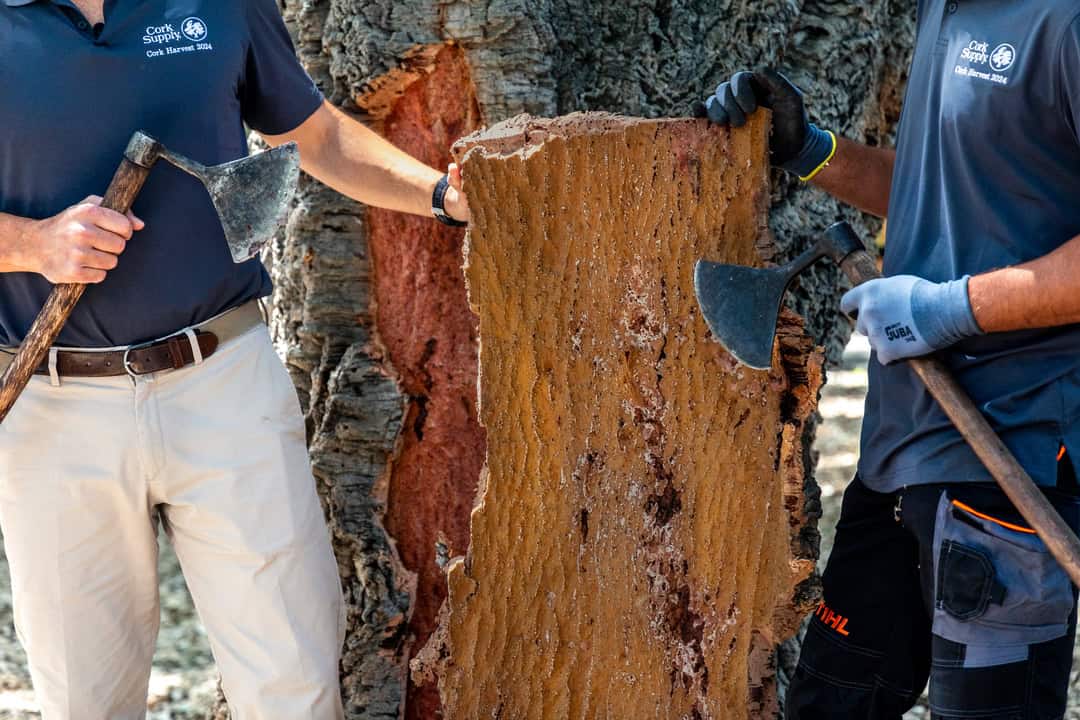
The cork from this harvest was not suitable for wine corks. As you’ll recall, the composition isn’t appropriate for a wine closure until the third harvest. Greg plans on taking a piece or two home as a keepsake, but the rest will likely be mulched.
Greg explains, “I’m an alumni of the viticulture and enology department here. One of the things I’ve always dreamed about doing is bringing Cork Supply back to Davis. But when we come back, hopefully nine years from now, and take that next layer off, my dream is that we’ll be able to make some corks and donate them to the Department of Viticulture and Enology – to actually put in some bottles.”
In the meantime, the debarked trees will serve as a conversation starter, helping to educate others across the campus about the importance of cork trees. Emily adds, “The trees are gonna look quite different, so that will be a conversation point for helping people understand more about these trees and also just generally to appreciate the value of trees in nature.”
Want to learn more about California wines? Start here.
